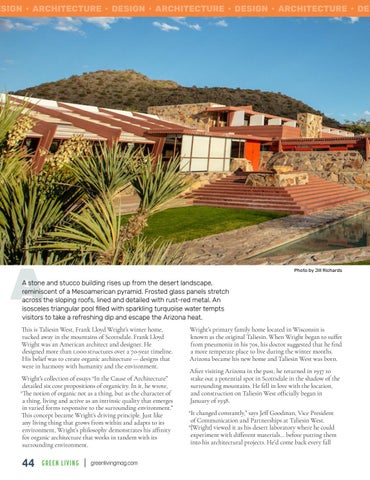ARCHITECTE•DE UR SIGN•ARCHITECTE•DE UR SIGN•ARCHITECTE•DE UR SIGN•ARCHITECTE•DE UR SIGN•ARCHITECTE•DE UR SIGN•ARCHITECTE•DE UR SI G N
A
Photo by Jill Richards
A stone and stucco building rises up from the desert landscape, reminiscent of a Mesoamerican pyramid. Frosted glass panels stretch across the sloping roofs, lined and detailed with rust-red metal. An isosceles triangular pool filled with sparkling turquoise water tempts visitors to take a refreshing dip and escape the Arizona heat.
This is Taliesin West, Frank Lloyd Wright’s winter home, tucked away in the mountains of Scottsdale. Frank Lloyd Wright was an American architect and designer. He designed more than 1,000 structures over a 70-year timeline. His belief was to create organic architecture — designs that were in harmony with humanity and the environment. Wright’s collection of essays “In the Cause of Architecture” detailed six core propositions of organicity. In it, he wrote, “The notion of organic not as a thing, but as the character of a thing, living and active as an intrinsic quality that emerges in varied forms responsive to the surrounding environment.” This concept became Wright’s driving principle. Just like any living thing that grows from within and adapts to its environment, Wright’s philosophy demonstrates his affinity for organic architecture that works in tandem with its surrounding environment.
44
GREEN LIVING
|
greenlivingmag.com
Wright’s primary family home located in Wisconsin is known as the original Taliesin. When Wright began to suffer from pneumonia in his 70s, his doctor suggested that he find a more temperate place to live during the winter months. Arizona became his new home and Taliesin West was born. After visiting Arizona in the past, he returned in 1937 to stake out a potential spot in Scottsdale in the shadow of the surrounding mountains. He fell in love with the location, and construction on Taliesin West officially began in January of 1938. “It changed constantly,” says Jeff Goodman, Vice President of Communication and Partnerships at Taliesin West. “[Wright] viewed it as his desert laboratory where he could experiment with different materials… before putting them into his architectural projects. He’d come back every fall
